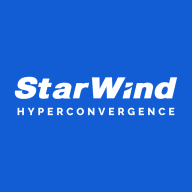


StarWind HyperConverged Appliance (HCA) and Nutanix Unified Storage (NUS) compete in the hyperconverged infrastructure sector. Nutanix might have the upper hand due to its robust cloud integration and unified storage management features.
Features: StarWind HCA integrates compute and storage with high availability and fault tolerance, delivering ease of deployment and management with a single console. It utilizes existing hardware like Dell EMC boxes and provides flexible performance options. Nutanix NUS offers high availability, scalability, and seamless integration with AWS and Azure. Its unified interface aids management across block, file, and object storage, enhanced by features for security, analytics, and ransomware protection.
Room for Improvement: StarWind HCA relies on Microsoft Windows Server as a hypervisor, presenting potential reliability concerns. Users suggest improving monitoring tools and simplifying the initial setup. Nutanix NUS faces challenges with complexity and pricing. Users desire enhanced customer service, better integration capabilities, and features for managing diverse storage requirements, particularly involving multiple VLANs and auditing.
Ease of Deployment and Customer Service: StarWind HCA's turnkey deployment is straightforward, and its customer support is renowned for responsiveness. Nutanix NUS offers extensive deployment options, including multicloud, potentially adding complexity. While Nutanix support is responsive, issues with pricing and licensing can complicate matters for enterprises transitioning from traditional storage environments.
Pricing and ROI: StarWind HCA is cost-effective, especially appealing for small to medium enterprises due to its efficient two-node operation and all-in-one pricing model. Nutanix NUS, more expensive, offers long-term ROI advantages, particularly for enterprises seeking comprehensive integration and redundancy. Nutanix's pricing strategies aim to provide value over time, especially for mid-to-large companies.
It does not require much management once you set up correctly, so it saves time, allowing an admin to focus on other work.
For me, the biggest return on investment when using this solution is that we do not have to have much support staff to run it.
The scalability challenge with previous systems is lessened with Nutanix since we can expand by adding new hardware without needing migrations.
We are saving approximately 20% to 25% compared with the competition.
I would rate them an eight out of ten.
The support is done through email and is not that great, making it a very problematic area I've been dealing with for over four years.
They come on the call, start troubleshooting immediately, and resolve issues effectively.
They are very knowledgeable, and if they can't solve the problem, they find the answer within a day or so.
I would give the customer service and technical support a ten out of ten.
Pure Storage FlashBlade is scalable.
This means you don't have to buy everything upfront; you can buy what you need and add more as you grow, which is advantageous.
These three components utilize scalability tools, enabling storage addition to nodes and supporting independent, linear performance growth.
I find the scalability of Nutanix Unified Storage (NUS) to be excellent, and I would rate it a ten based on my clients' requirements.
In case there is any issue with any blade, the data is moved to another.
We have not experienced these issues with Nutanix, which I attribute to the all-flash technology, the quality of their platform, and the responsiveness of the hyper-converged infrastructure.
Nutanix Unified Storage (NUS) is very stable.
It automatically triggers tasks, causing performance issues.
Technical support definitely needs significant improvement.
Its configuration should be easier.
The main concern is pricing, which could deter some customers; addressing this would enhance its appeal.
The system should move towards AI-driven optimization and enhance S3 object storage capabilities.
System downtime can disturb the entire ecosystem and impact all applications.
The pricing of Pure Storage FlashBlade is expensive compared to other products I used from other companies in the past, but one benefit is that they have built-in ransomware protection.
Compared to buying three or four vendor solutions, it is much cheaper.
The cost has doubled for the same amount of data, which was a challenge when presenting use case justifications for the increased cost.
Nutanix Unified Storage (NUS) has definitely helped reduce our total cost of ownership.
We can plug in many blades, and we can have data up to one terabyte.
The best features of Pure Storage FlashBlade include better throughput and better performance.
Nutanix Unified Storage (NUS) is appreciated for its fault tolerance and redundancy at the cluster level, which ensures reliable storage of files, folders, and other information accessible on the client side.
The cybersecurity features of Nutanix Unified Storage (NUS) when dealing with unstructured data, such as ransomware threats, provide the ability to detect and back up block-based storage, allowing me to restore repositories or sets of block storage with one button click, which is automatic.
My experience with using Nutanix Unified Storage (NUS) for data-intensive workloads is that we have many SQL Servers and they perform much better than they did when we used hybrid converged previously.
| Product | Market Share (%) |
|---|---|
| Nutanix Unified Storage (NUS) | 5.0% |
| Pure Storage FlashBlade | 4.1% |
| StarWind HyperConverged Appliance | 2.2% |
| Other | 88.7% |



| Company Size | Count |
|---|---|
| Small Business | 11 |
| Midsize Enterprise | 11 |
| Large Enterprise | 20 |
| Company Size | Count |
|---|---|
| Small Business | 27 |
| Midsize Enterprise | 30 |
| Large Enterprise | 63 |
| Company Size | Count |
|---|---|
| Small Business | 50 |
| Midsize Enterprise | 22 |
| Large Enterprise | 8 |
FlashBlade is the industry’s most advanced scale-out storage for unstructured data, powered by a modern, massively parallel architecture to consolidate complex data silos (like backup appliances and data lakes) and accelerate tomorrow’s discoveries and insights.
Nutanix Unified Storage provides high availability and seamless cloud platform integration, ensuring robust redundancy, scalability, and streamlined management. It supports hybrid cloud connectivity, enhancing storage security and performance.
Nutanix Unified Storage is designed for effective data protection across block, file, and object storage, offering features like ransomware detection and a centralized management interface through Prism Central. Users gain improved SLAs and IT cost savings through its efficient performance. Despite its user-friendly interface, there is a demand for enhanced security measures such as Multi-Factor Authentication and DLP. While its resilience is notable, users seek improvements in protocol compatibility, storage capabilities, pricing, and support processes.
What are the most important features of Nutanix Unified Storage?Industries implement Nutanix Unified Storage for tasks such as file storage, database performance improvement, and storage solution consolidation. Companies deploying virtual machines, securing against ransomware, connecting hybrid clouds, and backing up data find it useful. It supports workloads like Citrix VDI, Kubernetes, and research data, assisting many organizations migrating from legacy storage for better cost efficiency and reduced data center footprints.
For SMB, ROBO and Enterprises, who look to bring in quick deployment and operation simplicity to virtualization workloads and reduce related expenses, our solution is StarWind HyperConverged Appliance (HCA). It unifies commodity servers, disks and flash, hypervisor of choice, StarWind Virtual SAN, Microsoft Storage Spaces Direct or VMware Virtual SAN and associated software into a single manageable layer. The HCA supports scale-up by adding disks and flash, and scale-out by adding extra nodes.
StarWind HyperConverged Appliance consists of StarWind Virtual SAN, Microsoft Storage Spaces Direct or VMware Virtual SAN “Ready Nodes”, targeting those, who are building their virtualization infrastructure from scratch. In case there is an existing set of servers, we offer a “software only version”, which is essentially our years proven StarWind Virtual SAN. Basically, it’s the fuel powering StarWind HCA.
We monitor all Software Defined Storage (SDS) reviews to prevent fraudulent reviews and keep review quality high. We do not post reviews by company employees or direct competitors. We validate each review for authenticity via cross-reference with LinkedIn, and personal follow-up with the reviewer when necessary.